Iowa is home to a diverse range of bird species, from vibrant songbirds to large waterfowl. With its varied habitats including forests, wetlands, and open fields, the state attracts both year-round residents and seasonal migrants.
This guide introduces 37 common birds you’re likely to see in Iowa. Each bird includes clear photos and helpful identification tips to make your birdwatching experience enjoyable and rewarding.
Different Species of Birds in Iowa
Downy Woodpecker
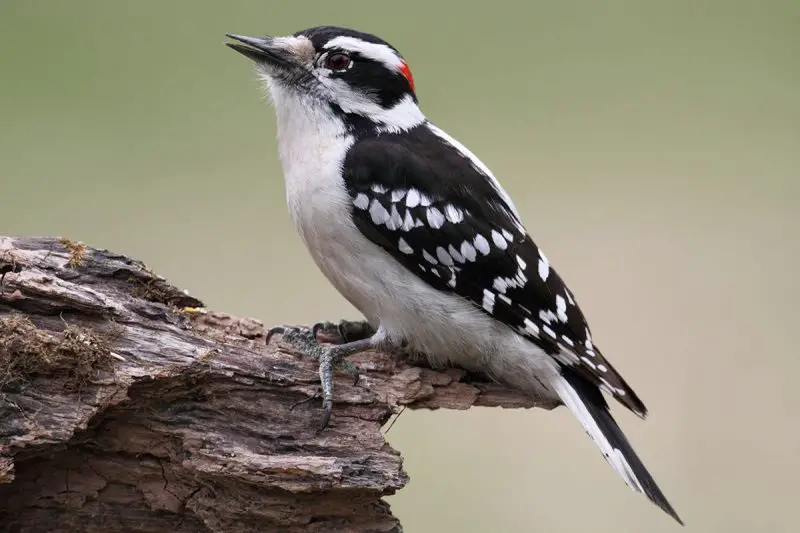
The Downy Woodpecker is the smallest woodpecker species in North America, measuring around 5.5 to 7 inches long with a wingspan of 9 to 12 inches. It features a bold black-and-white pattern with a white chest and back, and males have a small red patch on the back of the head. Its short bill is noticeably smaller compared to other woodpeckers, helping distinguish it from its close cousin, the Hairy Woodpecker.
This bird is common throughout Iowa and can be found year-round. It frequents wooded areas, backyard feeders, orchards, and parks, where it taps on tree trunks and branches to find insects. It also eats seeds, berries, and suet. Unlike larger woodpeckers, the Downy is agile and often seen climbing thin branches or even hanging upside down to forage.
Downy Woodpeckers are non-migratory and often remain within their territories even during harsh winters. A fun fact: despite their small size, they can drum with surprising speed—up to 16 beats per second—which helps them communicate with potential mates and rivals.
American Robin

The American Robin is one of the most recognizable birds across North America, known for its bright orange-red breast and cheerful song. Adult robins have grayish-brown backs, white undertails, and a distinctive yellow beak. Their upright posture and frequent presence on lawns make them easy to spot, especially in the early morning hours when they’re most active.
Robins are medium-sized songbirds, measuring about 9 to 11 inches in length with a wingspan of 12 to 16 inches. In Iowa, they are a common sight throughout the year, though many migrate south during the coldest winter months. They forage mostly on the ground for worms and insects, and they are also fond of fruits and berries when available.
These birds thrive in a variety of habitats including suburban lawns, open woodlands, orchards, and parks. Robins are among the first birds to sing at dawn and are often seen as harbingers of spring. A fun fact: male robins can be heard singing even before sunrise during the breeding season, which helps them establish territory and attract mates.
Hairy Woodpecker
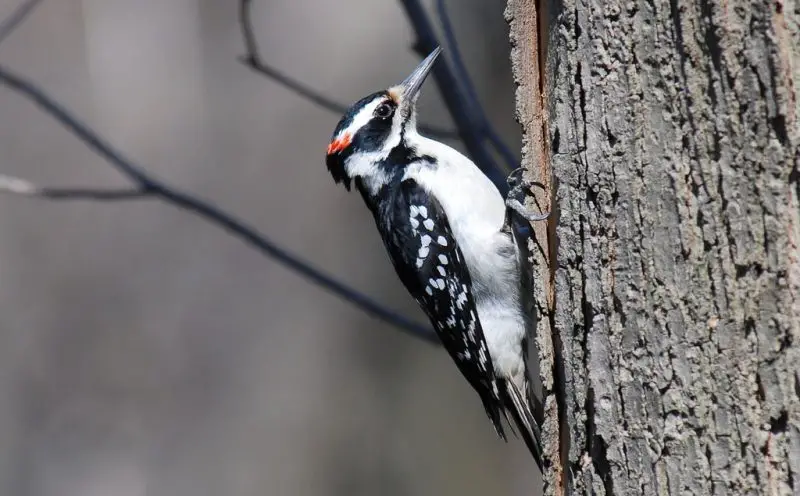
The Hairy Woodpecker is similar in appearance to the Downy but is noticeably larger, measuring 9 to 10 inches in length with a wingspan of 13 to 16 inches. It has a clean black-and-white color pattern and a long, sturdy bill that’s nearly as long as its head. Males also have a red patch on the back of their head, like Downies, making field identification challenging without noting size and bill length.
These woodpeckers inhabit mature forests, wooded suburbs, and tree-lined areas throughout Iowa. They forage primarily on tree trunks, using their powerful beaks to chisel into bark in search of beetle larvae and other insects. They are more elusive than Downy Woodpeckers but are still commonly detected by their loud, sharp “peek” calls and rhythmic drumming.
Hairy Woodpeckers play an important role in controlling forest pests by feeding on wood-boring insects. A fun fact: their stiff tail feathers act like a prop to support their bodies as they cling to vertical tree surfaces, helping them balance during intense pecking sessions.
American Goldfinch
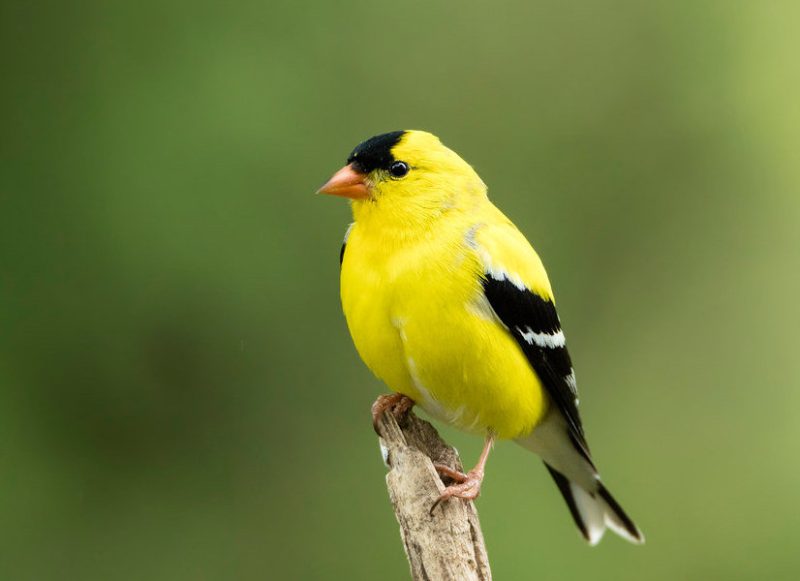
The American Goldfinch is a small, vibrant songbird well known for its bright yellow plumage and cheerful, undulating flight. Males are especially striking during the breeding season, sporting lemon-yellow bodies with black wings and caps, while females are more subdued in olive and yellowish hues. In winter, both sexes molt into a duller brownish color, blending more easily into the landscape.
Goldfinches measure about 4.5 to 5 inches long with a wingspan of 7.5 to 8.5 inches. In Iowa, they are seen year-round but are most noticeable during summer when males are in full breeding plumage. They favor weedy fields, roadsides, gardens, and backyards with sunflower or nyjer feeders. Unlike many birds, they breed later in the season, often waiting for thistles and other seed plants to mature.
These birds are almost exclusively seed-eaters and rarely eat insects. A fun fact: their flight pattern is bouncy and musical, often accompanied by a lilting “per-chick-o-ree” call that rises and falls with each flap and glide. They are the state bird of Iowa, symbolizing cheer and resilience.
House Sparrow
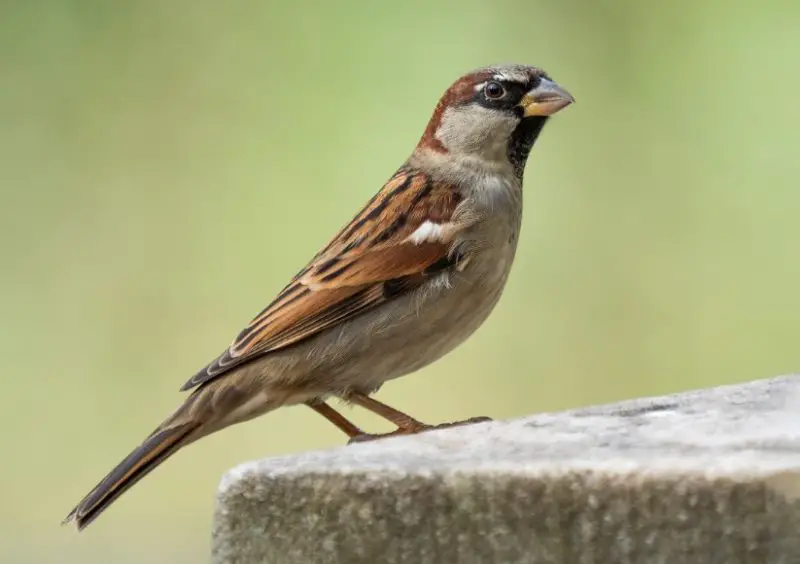
The House Sparrow is a small, stocky bird introduced to North America from Europe in the mid-1800s and is now one of the most widespread urban birds in Iowa and beyond. Males have gray crowns, black bibs, chestnut napes, and streaked brown backs, while females are paler with a more uniform brown and gray appearance. They’re commonly found near human activity and are easily spotted in cities, towns, and farms.
Measuring about 6 inches in length with a wingspan of 7.5 to 9.8 inches, House Sparrows are aggressive and adaptable. They feed on a wide variety of food including grains, seeds, scraps, and insects. In urban areas, they readily nest in buildings, vents, and signs, often displacing native bird species such as bluebirds or swallows from nesting sites.
These sparrows are year-round residents in Iowa and thrive wherever people live. A fun fact: House Sparrows have been known to mimic the calls of other birds and even learn to recognize the sound of doors opening—often signaling a chance to dash in and grab food crumbs from cafes or patios.
House Finch
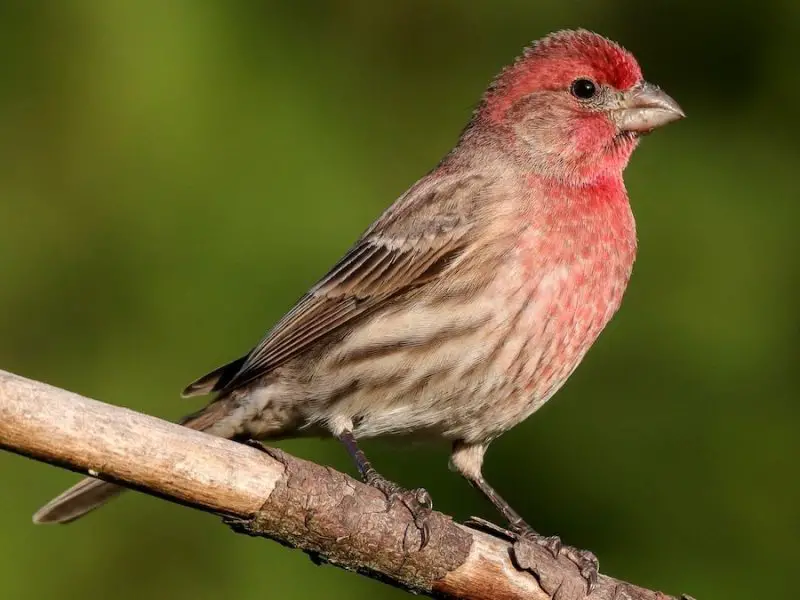
The House Finch is a small, colorful songbird with a cheerful presence in urban and suburban areas. Males are recognized by their rosy-red foreheads, chests, and rumps, while females are streaked brown with no red. Both sexes have conical beaks adapted for seed-eating and a slightly notched tail that helps in identification.
Measuring about 5 to 6 inches long with a wingspan of 8 to 10 inches, House Finches are common in Iowa throughout the year. They are particularly fond of feeders filled with sunflower seeds and often arrive in flocks. These birds are known for their musical, warbling songs that males sing from rooftops or treetops to defend their territory and attract mates.
House Finches originally lived in the western United States but were introduced to the East in the 1940s and have since expanded rapidly. A fun fact: males get their red color from pigments in their diet, so those with more vibrant red plumage are often healthier and more attractive to females.
American Crow
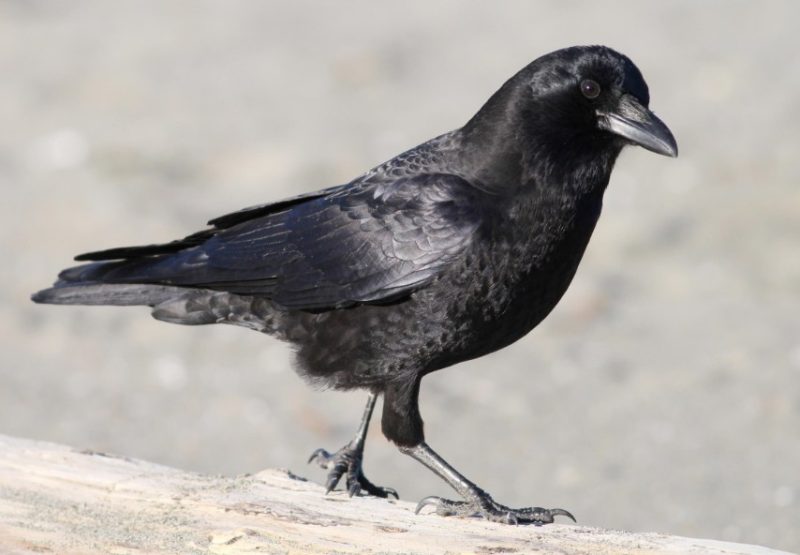
The American Crow is a large, intelligent, and entirely black bird with a thick bill and a loud, unmistakable “caw.” Its plumage has a glossy sheen, and it walks or hops confidently on the ground. Crows are often confused with ravens, but they are smaller and have fan-shaped tails rather than wedge-shaped ones.
These birds reach lengths of 16 to 21 inches with wingspans ranging from 33 to 39 inches, making them one of the larger songbirds in Iowa. They are year-round residents and adapt easily to cities, farmland, forests, and open fields. Omnivorous and opportunistic, American Crows feed on insects, grains, carrion, and even garbage, often foraging in groups.
Highly social and intelligent, crows are capable of using tools, solving problems, and recognizing human faces. A fun fact: they hold funerals—when a crow dies, others gather around and vocalize, possibly to investigate the cause of death or alert others of danger in the area.
Song Sparrow
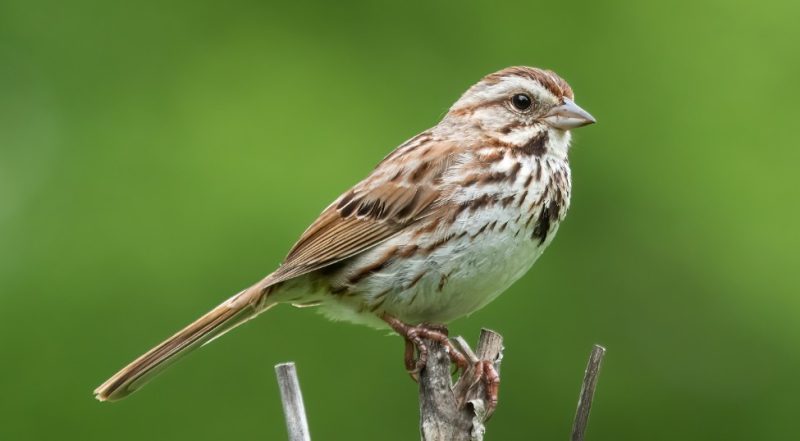
The Song Sparrow is a small, streaky brown bird with a rounded head, short bill, and long, rounded tail. Its most notable field mark is a dark central spot on its heavily streaked breast. Despite its plain appearance, it is named for its beautiful and varied song, which consists of several sweet notes followed by buzzy trills.
Song Sparrows measure 5 to 7 inches long with a wingspan of about 7.5 to 9.5 inches. They are year-round residents in Iowa, though some individuals may migrate slightly south in winter. These sparrows thrive in a range of habitats, including wetlands, brushy fields, gardens, and woodland edges. They forage mostly on the ground for seeds and insects, especially during the breeding season.
Song Sparrows are extremely adaptable and vary in appearance depending on their geographic location, with over 20 recognized subspecies across North America. A fun fact: males sing up to 20 different song variations and may learn songs from neighboring sparrows, creating local dialects.
Northern Cardinal
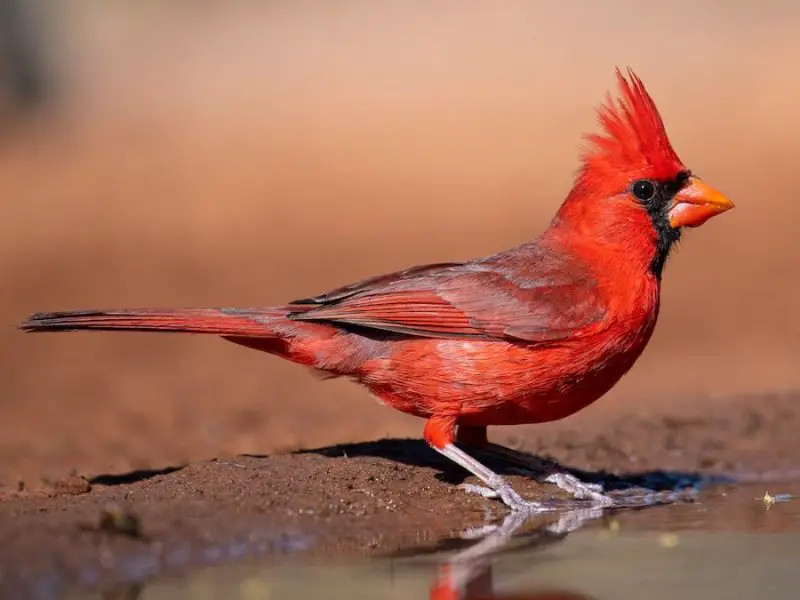
The Northern Cardinal is one of the most beloved backyard birds in North America, instantly recognizable by the male’s brilliant red plumage and crest. Females are more subdued, with soft tan coloring and hints of red on their wings and crest. Both sexes have thick orange-red beaks and a distinctive black mask around the face.
Cardinals are medium-sized songbirds, measuring 8 to 9 inches long with a wingspan of 10 to 12 inches. They are year-round residents throughout Iowa and prefer habitats with dense shrubs, woodland edges, suburban yards, and parks. They feed on seeds, berries, and insects and often visit feeders, especially those stocked with sunflower seeds or safflower.
Known for their rich, whistling songs, both males and females sing—unusual among songbirds. A fun fact: Northern Cardinals can see in ultraviolet light, which enhances their ability to spot food and may even play a role in mate selection based on how their plumage appears under UV.
Blue Jay
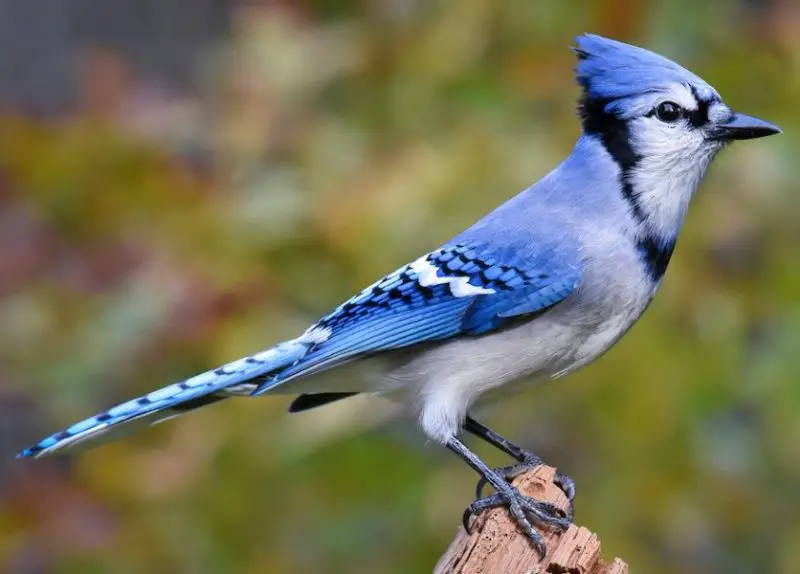
The Blue Jay is a striking bird with bold blue, white, and black plumage and a loud, varied voice. It has a prominent crest on its head and a sturdy black bill. Blue Jays are known for their intelligence, curiosity, and complex social behavior. Their bright coloration and raucous calls make them highly noticeable in both wooded and suburban environments.
They measure around 9 to 12 inches in length with a wingspan of 13 to 17 inches. In Iowa, Blue Jays are present year-round and are especially active in fall when they collect and store acorns and other nuts for winter. They inhabit woodlands, parks, and residential areas, often traveling in noisy family groups or flocks.
Despite their flashy appearance, Blue Jays are excellent mimics and can imitate the calls of hawks to scare away other birds. A fun fact: they play a crucial role in forest regeneration by burying acorns, many of which go uneaten and eventually sprout into new oak trees.
Mourning Dove

The Mourning Dove is a slender, medium-sized bird with soft beige-brown plumage, black spots on the wings, and a long, pointed tail edged in white. Its mournful cooing call gives the species its name and is often heard in the early morning or evening. These doves have small heads, pinkish legs, and a calm, gentle presence.
They measure about 9 to 13 inches in length with a wingspan of 17 to 18 inches and are among the most abundant and widespread birds in Iowa. Mourning Doves are commonly seen perched on power lines, foraging for seeds on the ground, or fluttering away with fast, whistling wingbeats when startled. They prefer open habitats such as farmland, grasslands, suburban yards, and roadsides.
These doves often raise multiple broods in a single breeding season, with nests placed on horizontal branches or even building ledges. A fun fact: Mourning Doves can drink water without tilting their heads back—an unusual trait among birds.
White-breasted Nuthatch
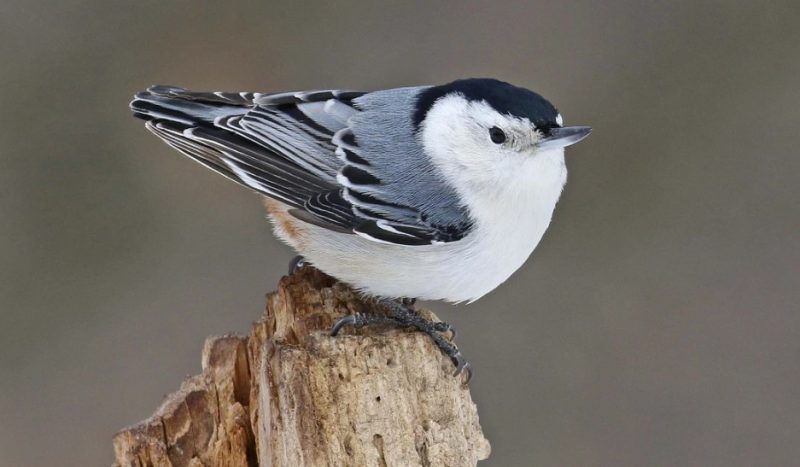
The White-breasted Nuthatch is a compact, agile bird with a bluish-gray back, clean white face and underparts, and a black or gray crown. It has a short tail, long bill, and a distinctive habit of creeping headfirst down tree trunks. Its nasal “yank-yank” call is often heard in deciduous woodlands.
This species measures about 5 to 6 inches long with a wingspan of 8 to 10 inches. It is a permanent resident in Iowa, particularly in mature forests and wooded neighborhoods with large trees. White-breasted Nuthatches forage for insects, seeds, and nuts by probing bark crevices, and they are known to store food in tree bark for later use.
These birds often join mixed-species flocks in winter and will visit backyard feeders, especially for sunflower seeds and suet. A fun fact: they coat cached food with tree resin or bark flakes to hide it and may even return later to check if it’s still there.
Red-bellied Woodpecker
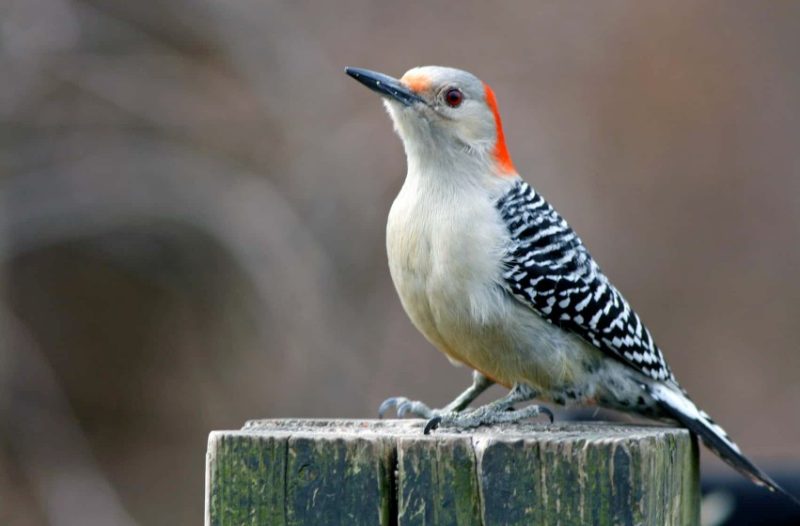
The Red-bellied Woodpecker is a medium-sized bird with a striking appearance, including black-and-white barred wings and back, pale underparts, and a subtle reddish wash on the belly that is often hard to see. Males have a red crown that extends from the bill to the nape, while females have red only on the nape and back of the head.
These woodpeckers measure about 9 to 10.5 inches long with a wingspan of 13 to 17 inches. They are common year-round residents in Iowa, favoring woodlands, forest edges, and suburban areas with mature trees. Red-bellied Woodpeckers feed on insects, fruits, seeds, and occasionally small vertebrates. Their loud “churr” calls and rolling drumming are common sounds in eastern woodlands.
Despite the name, the red belly is rarely the most noticeable feature; their bright red heads often draw more attention. A fun fact: they have a long, barbed tongue that can extend nearly two inches past the tip of the beak—perfect for extracting insects from deep crevices.
European Starling
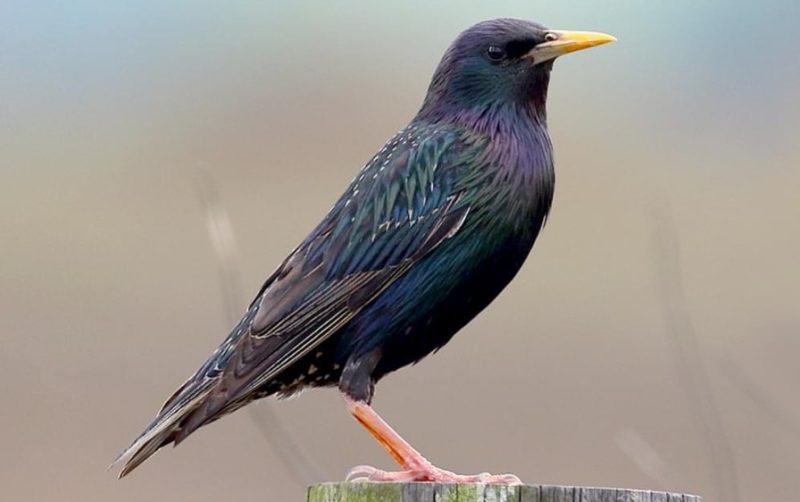
The European Starling is a glossy, dark bird with a short tail, pointed yellow bill, and iridescent feathers that shimmer with green and purple tones in the light. In winter, their plumage becomes speckled with white, giving them a spotted appearance. They are known for their harsh, varied calls and ability to mimic sounds.
Measuring about 7.5 to 9 inches long with a wingspan of 12 to 16 inches, European Starlings are found across Iowa in large numbers year-round. They thrive in urban areas, farms, fields, and parks, often forming massive flocks called murmurations that twist and turn in synchronized flight. Starlings feed on insects, seeds, grains, and even garbage.
Originally introduced from Europe in the 1890s, they have since spread rapidly and now compete with native birds for nesting sites. A fun fact: all the starlings in North America are descendants of about 100 birds released in New York City’s Central Park.
Black-capped Chickadee

The Black-capped Chickadee is a tiny, curious songbird with a black cap and bib, white cheeks, and soft gray back and wings. It has a short neck, a rounded body, and a signature “chick-a-dee-dee-dee” call, from which it gets its name. These birds are beloved for their friendly nature and quick, acrobatic movements.
Chickadees measure about 4.5 to 5.5 inches in length with a wingspan of 6.5 to 8 inches. They are common year-round throughout Iowa, especially in forests, wooded edges, parks, and backyards. They readily visit feeders, especially for sunflower seeds, suet, and peanuts. In colder months, they often join mixed-species foraging flocks and can be quite bold around humans.
These birds have incredible memory and can hide food in hundreds of locations, remembering them all for weeks. A fun fact: to survive harsh winters, they fluff up their feathers for insulation and can lower their body temperature at night to conserve energy.
Tufted Titmouse

The Tufted Titmouse is a small, active songbird with soft gray plumage, a white face, and a distinctive pointed crest on its head. It has a black patch just above the bill and rust-colored flanks that add a touch of warmth to its overall appearance. Its large black eyes give it a curious, alert expression.
This bird measures around 5.5 to 6.3 inches in length with a wingspan of about 8 to 10 inches. In Iowa, the Tufted Titmouse is a year-round resident, found mostly in deciduous or mixed woodlands and backyard areas with mature trees. It often visits feeders, especially those offering sunflower seeds, peanuts, or suet, and is frequently seen hanging upside down while foraging.
Tufted Titmice are social birds, often traveling in small flocks with chickadees and nuthatches. A fun fact: they are known to use hair or fur from live animals—such as dogs, squirrels, or even humans—to line their nests, sometimes plucking it directly from the source.
Common Grackle
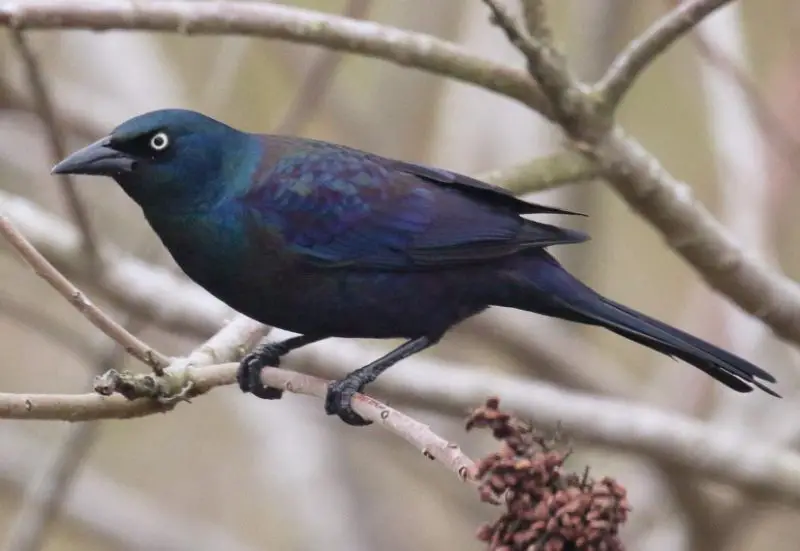
The Common Grackle is a large, lanky blackbird with iridescent plumage that shines with hues of blue, purple, and bronze in the sunlight. It has a long, keel-shaped tail and bright yellow eyes that stand out against its dark face. Its vocalizations are harsh and mechanical, often sounding like rusty gates or electronic buzzes.
Grackles measure about 11 to 13 inches long with a wingspan of 14 to 18 inches. They are widespread in Iowa during the warmer months and migrate short distances south in winter. These birds thrive in open woodlands, farmlands, suburban lawns, and wetlands. They feed on insects, grains, seeds, and even small animals such as frogs or baby birds.
Often forming large, noisy flocks, Common Grackles can dominate feeders and displace smaller songbirds. A fun fact: grackles have been observed using their beaks to pry open acorns or dunking food in water to soften it before eating.
Dark-eyed Junco
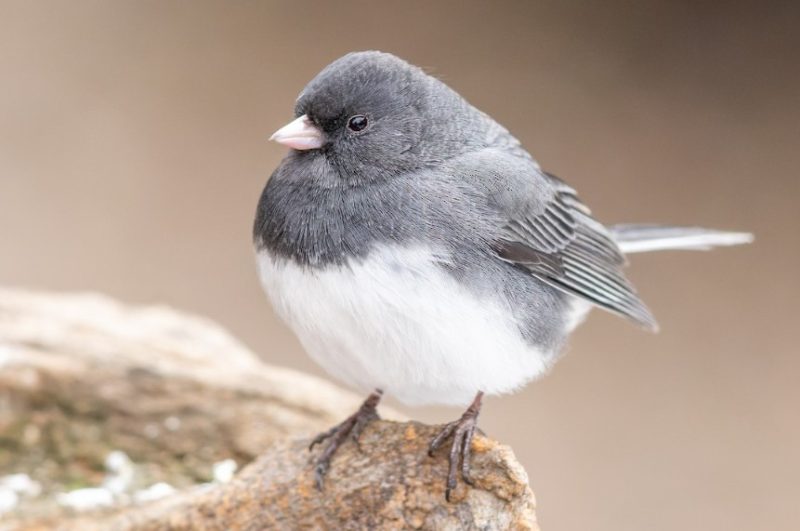
The Dark-eyed Junco is a small sparrow that varies slightly in appearance across its range, but in Iowa, the most common type has a slate-gray head and upper body, white belly, and pink bill. Its crisp contrast and clean lines make it easy to recognize, especially against the snow.
Measuring 5 to 6.5 inches long with a wingspan of 7 to 10 inches, juncos are familiar winter visitors across Iowa. They breed in northern forests and higher elevations but migrate south to Iowa for the colder months. These birds favor open woodlands, forest edges, and shrubby habitats, and they often forage on the ground beneath feeders.
Dark-eyed Juncos are often called “snowbirds” because their arrival signals the beginning of winter for many birdwatchers. A fun fact: they use their strong legs to scratch the leaf litter and snow, uncovering seeds and insects beneath the surface.
Northern Flicker
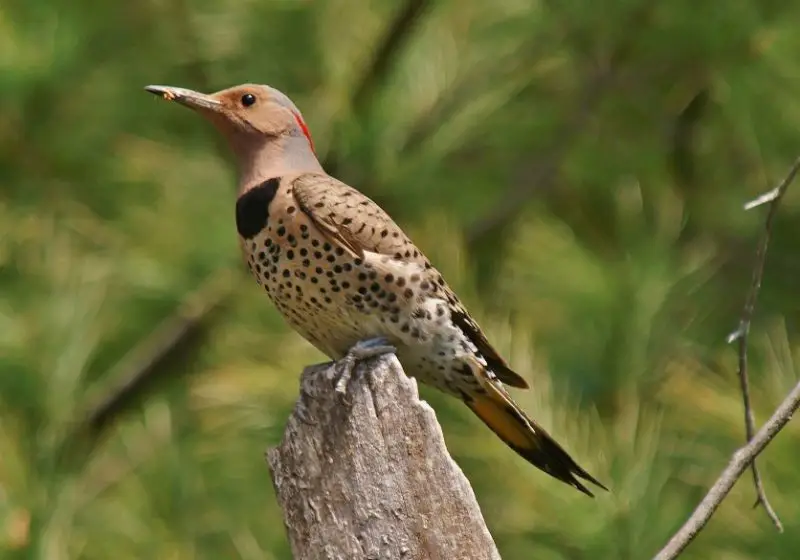
The Northern Flicker is a large, striking woodpecker with a brownish body, black-barred back, and a prominent black crescent on its chest. In Iowa, most flickers are of the “yellow-shafted” variety, named for the bright yellow feathers on the undersides of their wings and tail. Males have a black mustache stripe, which females lack.
Flickers are about 11 to 14 inches long with a wingspan of 17 to 21 inches. Unlike most woodpeckers, they often forage on the ground for ants and beetles, using their long, barbed tongue to probe into soil and rotting wood. They are common across Iowa in woodlands, parks, and even residential areas with open lawns.
These birds are known for their loud “wick-a-wick-a-wick” calls and distinctive, swooping flight. A fun fact: Northern Flickers are one of the few woodpecker species that migrate, and their ground-foraging behavior sets them apart from their more tree-bound relatives.
Eastern Bluebird
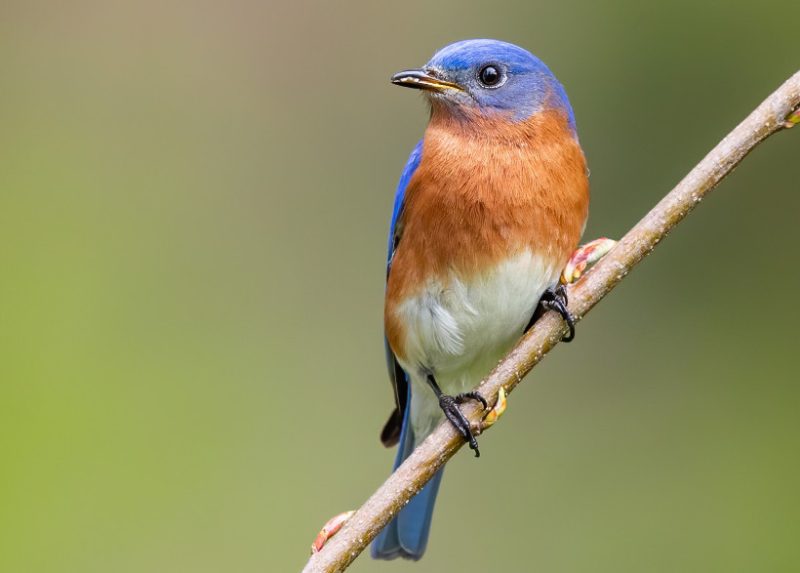
The Eastern Bluebird is a small thrush with a brilliant royal blue back, reddish-brown chest, and white belly. Males are especially vivid in color, while females are paler with more subdued tones. Their posture is upright, and their sweet, warbling song is a welcome sound in spring and summer.
Measuring about 6.5 to 7 inches in length with a wingspan of 9.5 to 12 inches, Eastern Bluebirds are found across Iowa, especially in open countryside with scattered trees, pastures, orchards, and nest box trails. They are cavity nesters and readily accept man-made nest boxes, which has helped their population recover after historical declines.
Eastern Bluebirds feed mostly on insects during the breeding season and switch to berries and fruits in fall and winter. A fun fact: they can spot and catch insects from over 20 feet away, making them efficient aerial hunters despite their gentle appearance.
Brown-headed Cowbird

The Brown-headed Cowbird is a stocky blackbird with a short tail and thick, conical bill. Males have glossy black bodies with a rich, chocolate-brown head, while females are plain brown with faint streaking and lighter underparts. Their appearance is modest, but their behavior is highly distinctive in the bird world.
These birds measure about 7 to 8.5 inches long with a wingspan of 12 to 15 inches. They are common throughout Iowa during spring and summer, especially in grasslands, open fields, pastures, and suburban areas. Rather than building their own nests, cowbirds are brood parasites—they lay their eggs in the nests of other bird species and leave the host parents to raise their chicks.
Brown-headed Cowbirds can lay up to 40 eggs in a single breeding season, often targeting small songbirds like warblers or sparrows. A fun fact: despite their sneaky tactics, cowbird chicks often grow faster and outcompete the host’s own young for food, sometimes resulting in the host chicks starving.
Carolina Wren
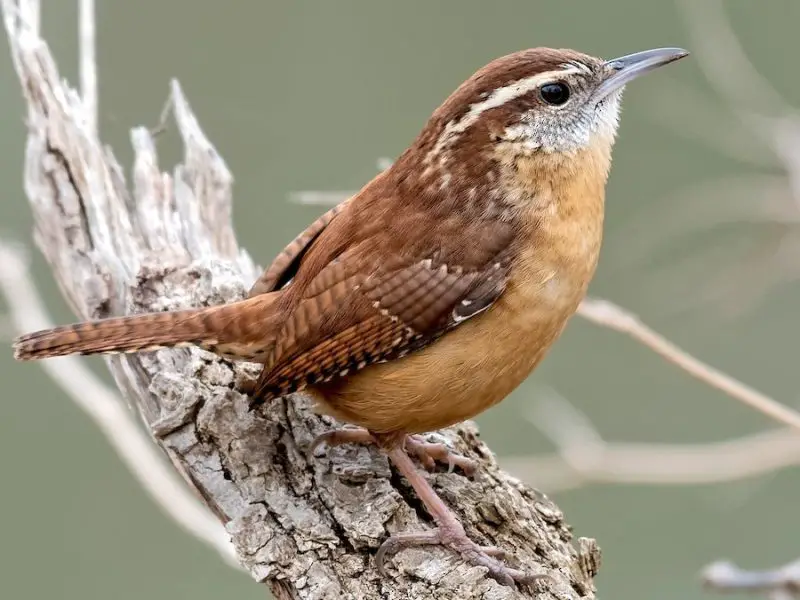
The Carolina Wren is a small, round-bodied bird with a bold personality and a loud, musical voice. It has rich reddish-brown upperparts, warm buff underparts, and a distinctive white eyebrow stripe. Its curved bill and cocked tail add to its alert, expressive appearance.
Measuring about 5.5 to 6 inches long with a wingspan of 7 to 9 inches, the Carolina Wren is most commonly found in the southeastern U.S. but has expanded its range northward and is now a regular year-round resident in southern Iowa. These wrens favor wooded yards, brushy thickets, and tangled undergrowth, where they search for insects and spiders.
Despite their small size, Carolina Wrens are among the loudest songbirds relative to their body weight. A fun fact: their pairs often stay together for life and sing duet-like calls to keep in contact while foraging or defending territory.
American Tree Sparrow
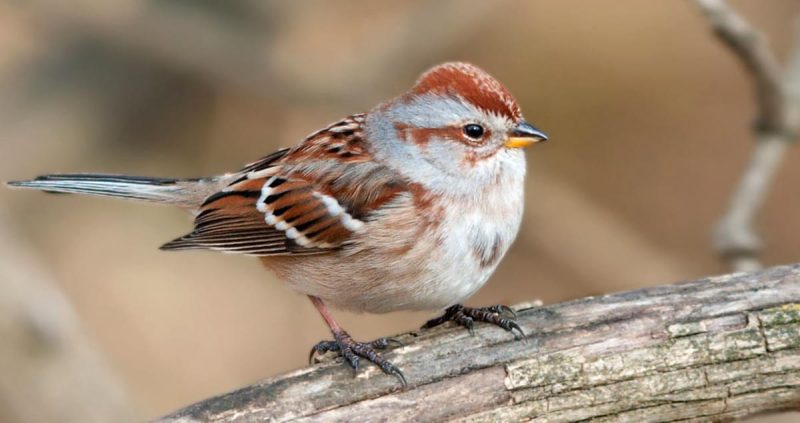
The American Tree Sparrow is a hardy winter visitor to Iowa, with a warm rufous crown, rusty eye-line, gray face, and a small dark central spot on its otherwise clean breast. Its back is streaked with browns, and its bicolored bill—black on top, yellow below—is a helpful field mark.
They are about 5.5 to 6.5 inches long with a wingspan of 9 inches. American Tree Sparrows breed in the tundra of northern Canada and Alaska and migrate to the central United States, including Iowa, for the winter months. They frequent weedy fields, brushy areas, and backyard feeders, often foraging in flocks on the ground for seeds.
Despite their name, these sparrows are more associated with open ground than trees during their time in Iowa. A fun fact: American Tree Sparrows often flutter their wings slightly while feeding on the ground, possibly to dislodge hidden seeds or insects.
Cedar Waxwing
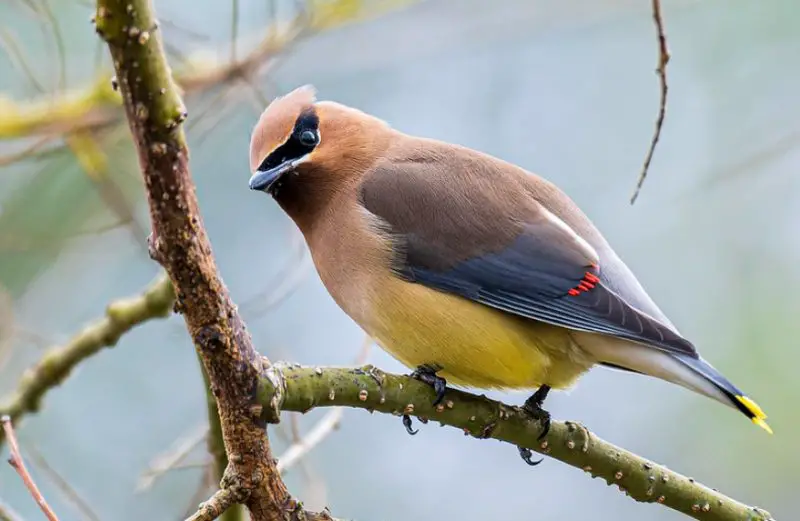
The Cedar Waxwing is a sleek, elegant bird with silky plumage in soft shades of brown, gray, and yellow. Its most distinctive features include a crest, a black mask across its face, and bright red wax-like tips on the wings. The tail ends with a striking yellow band, and some birds in certain areas may even show orange instead.
They measure about 6 to 7 inches long with a wingspan of 8.5 to 11.5 inches. Cedar Waxwings are found year-round in parts of Iowa, with numbers increasing in summer as they breed in open woodlands, orchards, and areas with abundant fruiting trees. They are one of the few North American birds that feed heavily on fruit, often traveling in flocks to strip entire trees of berries.
Cedar Waxwings are known for their quiet, high-pitched whistles and gentle social behavior. A fun fact: when courtship feeding, a male and female may pass a berry or flower petal back and forth multiple times before one eats it.
Baltimore Oriole
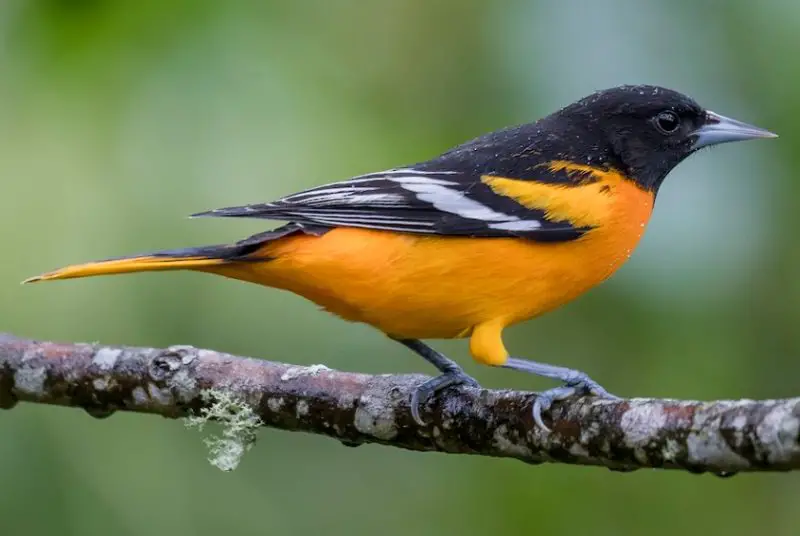
The Baltimore Oriole is a brightly colored songbird with striking orange and black plumage in males and more subdued yellow-orange tones in females. Males have black heads, backs, and wings with bright orange underparts and shoulders, while females display more grayish or olive on the back with yellow-orange fronts.
These birds are about 6.5 to 8 inches long with a wingspan of 9 to 12 inches. They are migratory and return to Iowa in late spring to breed in open woodlands, forest edges, and suburban areas with large shade trees. Baltimore Orioles feed on insects, fruits, and nectar and are fond of oranges and grape jelly at backyard feeders.
Baltimore Orioles build remarkable hanging, pouch-like nests that dangle from the ends of tree branches. A fun fact: they are named after the colors of Lord Baltimore’s coat of arms, which shares the same vibrant orange and black.
Indigo Bunting
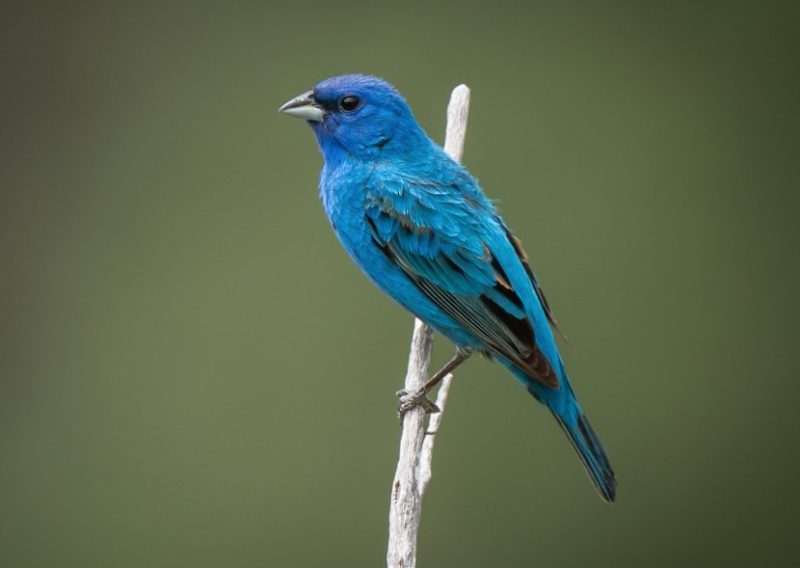
The Indigo Bunting is a strikingly beautiful songbird, especially the males, which are covered in vibrant, electric blue plumage during the breeding season. Females and juveniles, in contrast, are brown with subtle hints of blue. These small birds measure about 5.5 inches in length with a wingspan around 8.5 inches. Their stout beaks are well-suited for seed consumption.
In Iowa, Indigo Buntings are typically seen in summer, inhabiting woodland edges, brushy fields, roadsides, and powerline clearings. Males often sing from high perches to defend their territory and attract mates. Their song is a cheerful, jumbled warble that they repeat frequently throughout the day. Though small and shy, their singing makes them easier to locate in thick foliage.
A fun fact about the Indigo Bunting is that it migrates at night, using the stars to navigate. Scientists have found that these birds can orient themselves by the position of the stars in the night sky—an impressive trait for such a tiny traveler.
Chipping Sparrow
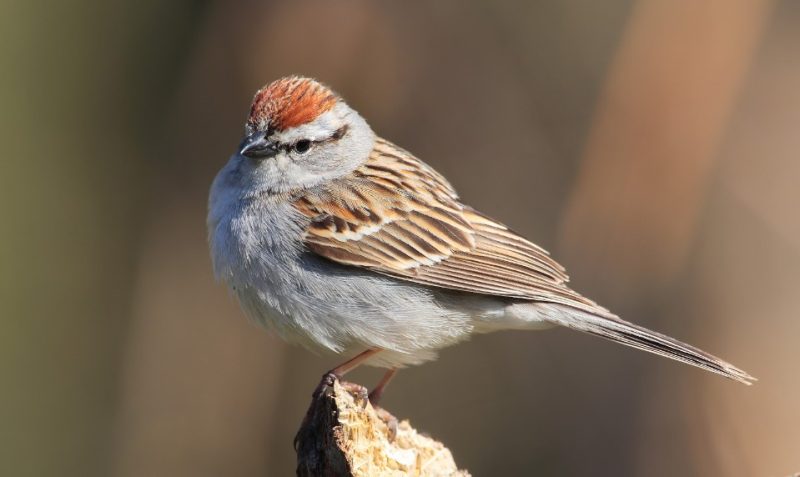
Chipping Sparrows are sleek, slim songbirds known for their clean, crisp appearance and distinctive rufous crown during breeding season. Their black eye-line and pale gray breast set them apart from other small sparrows. Adults average around 5.5 inches long with a wingspan of 8.3 inches.
In Iowa, they are common during spring and summer and prefer open woodlands, residential neighborhoods, and parks with scattered trees. They forage mainly on the ground for seeds and insects and are often spotted hopping in short bursts across lawns and sidewalks. Their trilling, mechanical song is one of the familiar sounds of an Iowa spring morning.
Chipping Sparrows are known for their flexible nesting habits. They readily nest in shrubs, small trees, or even hanging flower pots in suburban yards, making them frequent backyard visitors.
Red-winged Blackbird
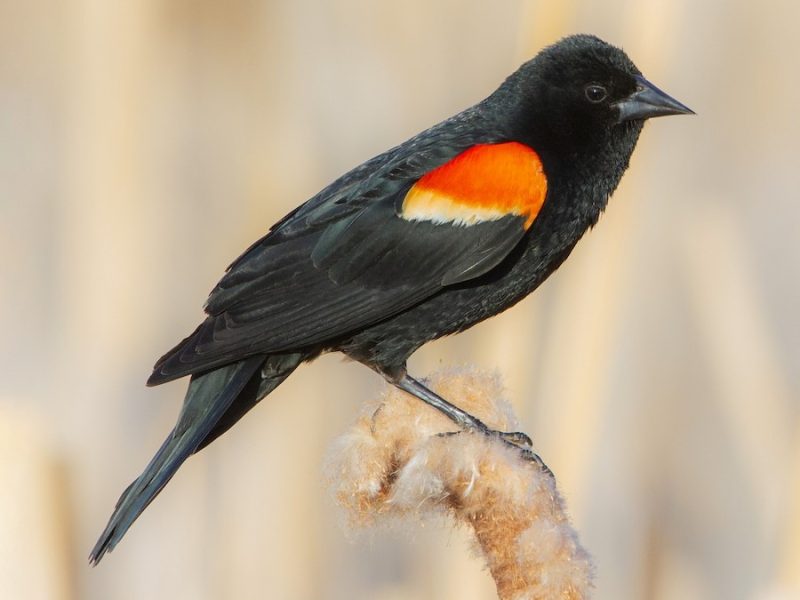
The Red-winged Blackbird is one of the most recognizable birds in Iowa, thanks to the males’ glossy black feathers and bright red shoulder patches bordered with yellow. Females look entirely different—streaky brown, resembling large sparrows. They measure about 7.5 to 9.5 inches in length with a wingspan of up to 15 inches.
These birds are commonly found in marshes, wetlands, and agricultural fields across Iowa. They perch on cattails or fence posts, loudly singing their familiar “conk-la-ree!” to declare territory. Males are highly territorial and will aggressively chase away intruders during the breeding season.
A fun fact about Red-winged Blackbirds is their social nature during migration and winter. Large flocks, sometimes in the thousands, can be seen roosting and feeding together in open fields alongside other blackbirds and starlings.
Barn Swallow
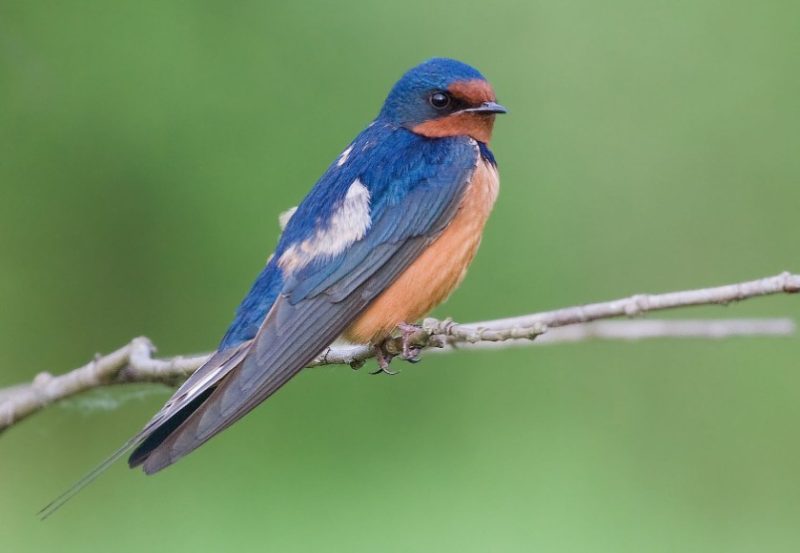
Barn Swallows are graceful, agile fliers known for their deeply forked tails and glossy blue backs. Their cinnamon-colored underparts and throat, along with a band of dark blue across the chest, give them a stylish look. Adults measure about 6.7 inches long with a wingspan around 12.6 inches.
These swallows are summer residents in Iowa and are often seen swooping over fields, ponds, and barns as they catch insects mid-air. They build cup-shaped mud nests in man-made structures like barns, bridges, and eaves. Their cheerful, twittering calls and flight displays are common in rural areas and farmland.
A fascinating trait of Barn Swallows is their long-distance migration. They travel thousands of miles between North America and their wintering grounds in Central and South America, navigating vast distances with remarkable precision.
Eastern Phoebe
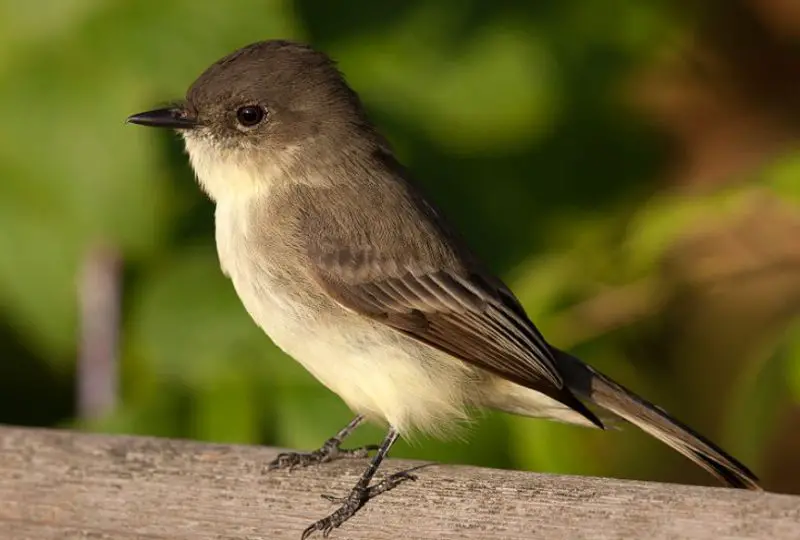
The Eastern Phoebe is a plain but charming flycatcher with a dull brownish-gray back and a whitish belly. It has a modest size of about 7 inches in length with a wingspan around 11 inches. Its tail-wagging behavior and soft “fee-bee” call make it easy to identify.
In Iowa, Eastern Phoebes return in early spring and prefer wooded areas near water, open fields with scattered trees, and human structures. They are among the earliest flycatchers to arrive and often nest under bridges, eaves, and ledges. Their diet consists mainly of insects caught during short flights from low perches.
One quirky behavior of the Eastern Phoebe is its tail-wagging motion, which it frequently performs while perched. This behavior may help it flush insects or signal to others, adding a touch of personality to this humble little bird.
Ruby-throated Hummingbird

The Ruby-throated Hummingbird is the only hummingbird species commonly found in Iowa. Males are easily identified by their iridescent ruby-red throat patch, known as a gorget, which flashes brilliantly in sunlight, while females lack this throat coloring and have a plain white chest. These tiny birds measure about 3 to 3.5 inches in length with a wingspan of approximately 4 inches.
They arrive in Iowa in late spring and stay through summer, frequenting gardens, woodland edges, and areas rich in flowering plants. Ruby-throated Hummingbirds feed primarily on nectar from flowers but also consume small insects for protein. Their rapid wingbeats create a humming sound, and they are known for their remarkable agility and ability to hover in mid-air.
A fun fact about Ruby-throated Hummingbirds is their incredible migratory journey. Many fly nonstop over the Gulf of Mexico—covering up to 500 miles in a single flight during migration—despite their tiny size and rapid metabolism.
Killdeer
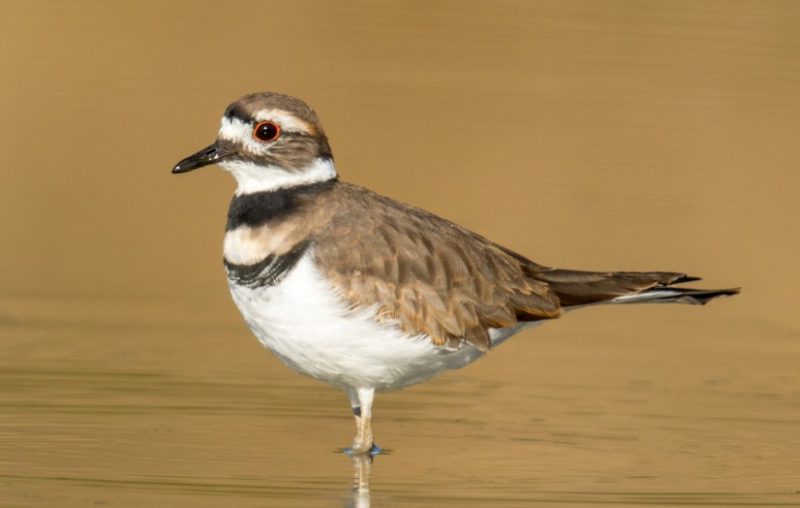
The Killdeer is a medium-sized plover characterized by its distinctive double black breast bands, brown back, and white belly. It has a slender body, long legs, and large dark eyes that help it spot predators. Killdeer measure about 10 to 11 inches in length with a wingspan of 18 to 22 inches.
Common in Iowa’s open fields, gravel roads, and shorelines, Killdeer are often seen running swiftly across the ground. They feed primarily on insects, worms, and other invertebrates. Known for their loud, piercing “kill-deer” call, these birds use distraction displays, such as pretending to have a broken wing, to lure predators away from their nests.
Killdeer nest on bare ground or gravel, sometimes even on rooftops, relying on camouflage to protect their eggs. A fun fact is that their young are precocial—able to run and feed themselves shortly after hatching, a survival advantage in their exposed nesting environments.
Great Blue Heron

The Great Blue Heron is a large, elegant wading bird with slate-gray plumage, a long S-shaped neck, and a sharp yellow bill. It stands around 4 feet tall with a wingspan reaching up to 6 feet. Its slow, deliberate movements and impressive size make it one of the most striking birds in Iowa’s wetlands.
This heron inhabits marshes, lakes, rivers, and ponds throughout the state, hunting fish, amphibians, and small mammals by standing still and striking quickly with its bill. Great Blue Herons often nest in colonies called rookeries, typically in tall trees near water.
A fascinating fact about this bird is its ability to remain motionless for long periods while waiting for prey. Additionally, they have a unique hunting technique where they use their feet to stir the water and flush out hidden fish.
Eastern Towhee
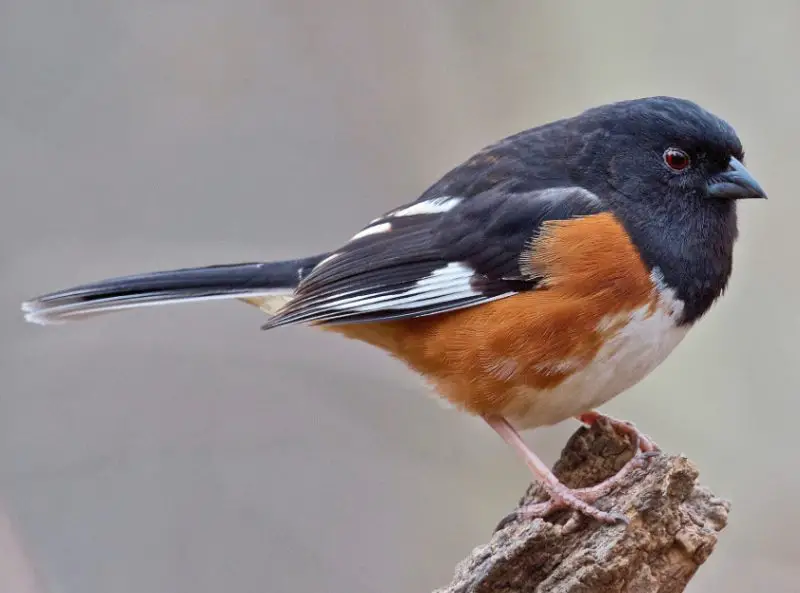
The Eastern Towhee is a striking sparrow with a black head, back, and tail, rusty sides, and a white belly. Males display the full color pattern, while females have brown where males have black. Towhees have a distinctive call described as “drink your tea” due to its rhythmic, melodious notes.
They measure approximately 7 to 8.5 inches in length with a wingspan around 10 to 12 inches. Eastern Towhees inhabit dense brush, woodland edges, and shrubby fields across Iowa. They forage on the forest floor, scratching through leaf litter to uncover seeds and insects.
Towhees are secretive but vocal, often heard before they are seen. A fun fact is their unique double-scratch behavior: they hop backward twice to expose insects and seeds hidden under leaves.
Gray Catbird
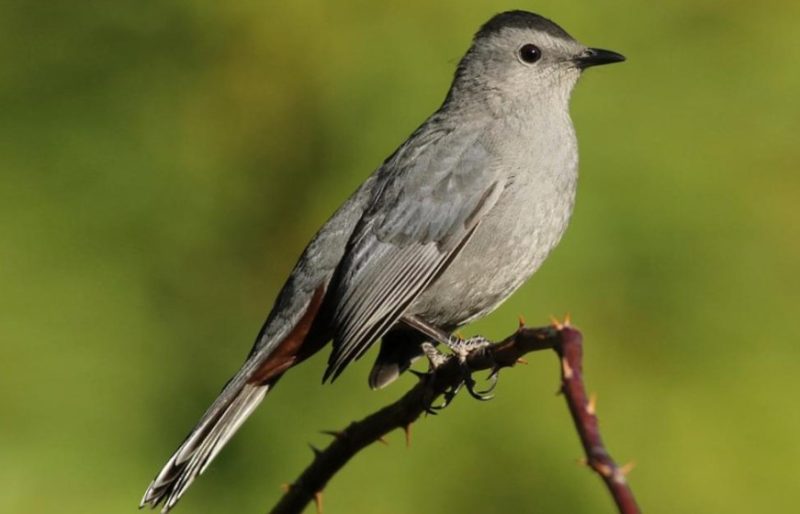
The Gray Catbird is a medium-sized songbird with a slate-gray body, black cap, and rusty undertail patch. Its plain appearance is contrasted by its loud, varied song, which includes meows, clicks, whistles, and mimicry of other birds. It measures about 8 to 9 inches in length with a wingspan of 11 to 13 inches.
Gray Catbirds are common in Iowa’s thickets, forest edges, and suburban gardens during the breeding season. They feed on insects, berries, and fruits. Their call, which resembles a cat’s meow, is one of their most distinctive and easily recognizable features.
These birds are skilled mimics and often combine sounds from their environment into complex songs. A fun fact is that Gray Catbirds can imitate other bird species, sometimes confusing both predators and birdwatchers alike.
Northern Mockingbird
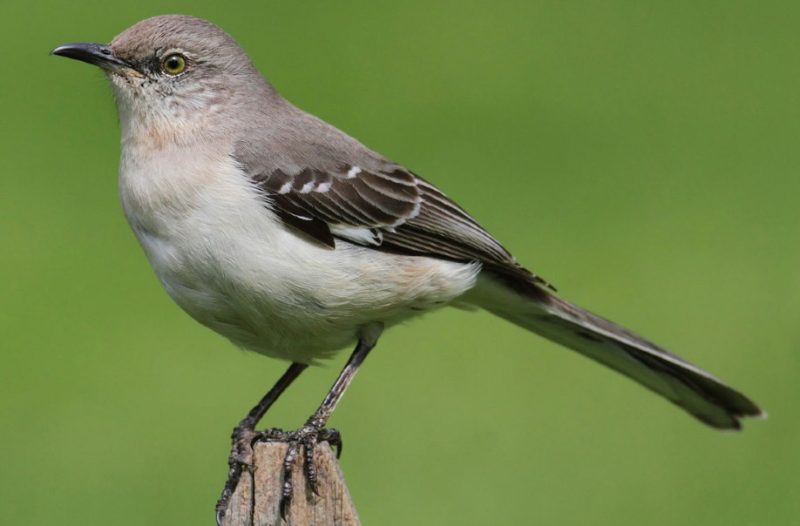
The Northern Mockingbird is a medium-sized gray bird with white patches on its wings and tail, which are visible during flight. It has a slender body, long tail, and sharp bill. Known for its incredible vocal ability, the mockingbird can imitate the songs of many other birds as well as mechanical noises.
Measuring about 8 to 10 inches in length with a wingspan of 12 to 15 inches, Northern Mockingbirds are year-round residents in Iowa, mostly in open habitats, suburban areas, and parks. They feed on insects, fruits, and berries and are fiercely territorial, especially during breeding season.
A fun fact about Northern Mockingbirds is their impressive song repertoire—an individual bird can learn up to 200 different songs and often repeats each phrase several times before switching to another.
Yellow-rumped Warbler
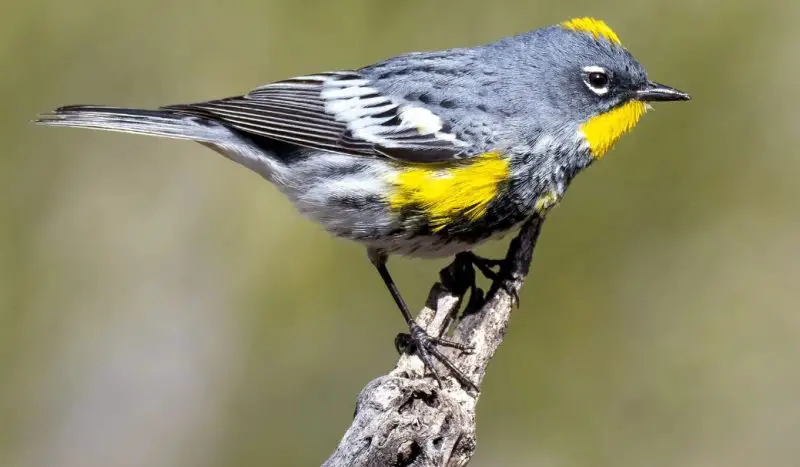
The Yellow-rumped Warbler is a medium-sized warbler with streaky gray and white plumage, a bright yellow patch on its rump, and yellow patches on the sides and crown. Males and females have similar markings, though males tend to be brighter during breeding season. These birds measure about 5 to 6.5 inches long with a wingspan of 8 to 11 inches.
They are migratory and can be found in Iowa during spring and fall migration as well as winter. Yellow-rumped Warblers inhabit forests, shrubby fields, and parks, feeding on insects and berries. They are one of the few warblers able to digest waxy berries, such as bayberries, allowing them to winter farther north than most warblers.
A fun fact is that their ability to digest waxy fruits gives them an important ecological niche during winter when other insects and fruits are scarce.
FAQs about Birds in Iowa
What are some common bird species found in Iowa?
Iowa is home to a diverse range of bird species including the American Robin, Northern Cardinal, Eastern Bluebird, Red-winged Blackbird, and Downy Woodpecker. The state’s varied habitats such as forests, wetlands, grasslands, and urban areas support both resident and migratory birds.
When is the best time to watch birds in Iowa?
Spring and fall migrations are the best times for birdwatching in Iowa, as many species pass through the state during these seasons. Summer is ideal for observing breeding birds, while winter offers opportunities to spot hardy residents like the Black-capped Chickadee and Dark-eyed Junco.
What habitats do Iowa birds prefer?
Birds in Iowa occupy a variety of habitats including woodlands, prairies, wetlands, riversides, agricultural fields, and suburban gardens. Each species has unique habitat preferences, such as waterfowl favoring wetlands and sparrows preferring grasslands or shrubby areas.
Are there any rare or endangered birds in Iowa?
Yes, Iowa is home to some rare and endangered species, such as the Piping Plover and the Least Tern, which nest on sandy riverbanks and lakeshores. Conservation efforts are ongoing to protect their habitats and increase their populations.
How can I attract more birds to my backyard in Iowa?
Providing native plants that offer food and shelter, installing bird feeders with appropriate seeds, and offering clean water sources like birdbaths can help attract a variety of birds. Avoiding pesticides and creating diverse habitats also encourages bird presence.
Do birds in Iowa migrate, and where do they go?
Many birds in Iowa migrate seasonally. Species like the Ruby-throated Hummingbird and Baltimore Oriole travel south to Central and South America for winter. Waterfowl and some songbirds move to southern states or Mexico, while a few species remain year-round.
What is the state bird of Iowa?
The Eastern Goldfinch, also known as the American Goldfinch, is the official state bird of Iowa. It is admired for its bright yellow plumage and cheerful song.
Can I go birdwatching in Iowa parks and wildlife refuges?
Yes, Iowa offers numerous parks, state forests, and wildlife refuges such as the Neal Smith National Wildlife Refuge and Loess Hills State Forest, which are excellent places for birdwatching with diverse habitats and public access.

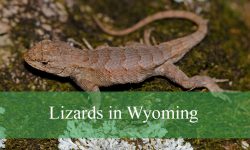
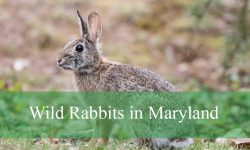

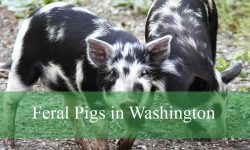
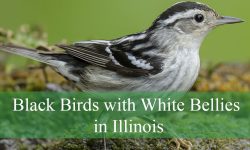
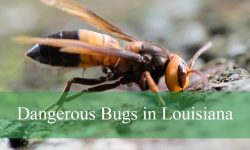
I noticed the red-headed woodpecker isn’t listed. I have had the joy of a pair of them coming to my bird feeder earlier this summer.
thanks for your info